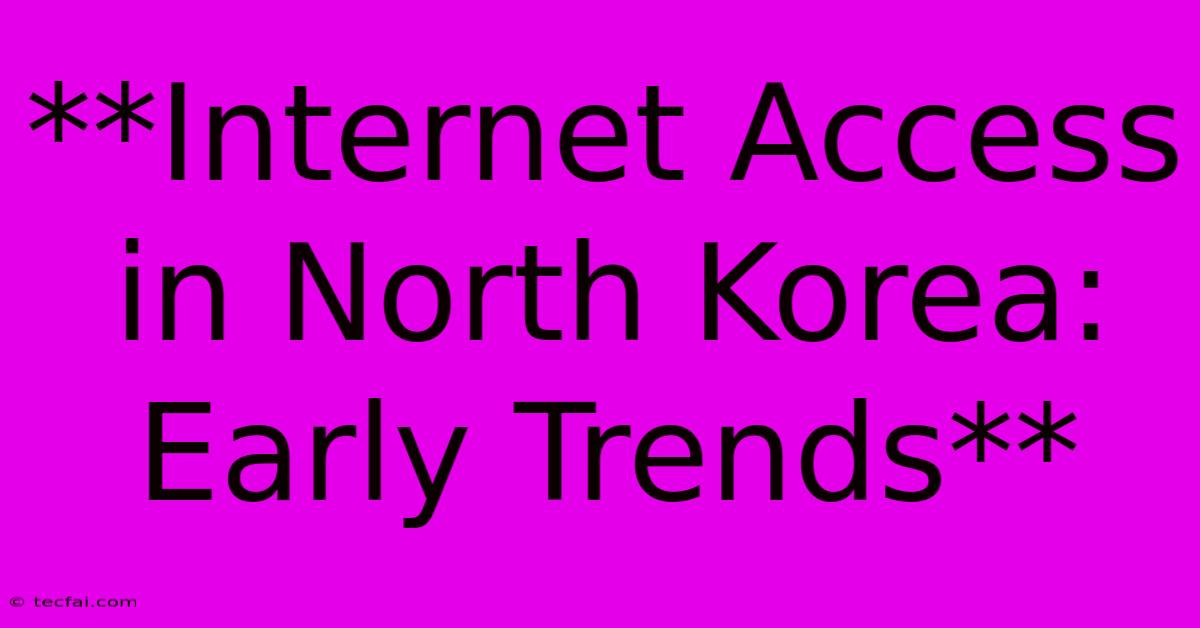**Internet Access In North Korea: Early Trends**

Discover more detailed and exciting information on our website. Click the link below to start your adventure: Visit Best Website tecfai.com. Don't miss out!
Table of Contents
Internet Access in North Korea: Early Trends
North Korea, a nation shrouded in secrecy, has long been known for its stringent control over information flow. While the country's citizens are largely isolated from the outside world, recent years have seen a subtle shift in internet access, sparking curiosity about its future direction. This article explores the early trends of internet access in North Korea, its limitations, and the potential implications of these developments.
A Glimmer of Connection
Unlike the global internet that connects billions, North Korea operates a separate, highly controlled intranet known as Kwangmyong. This closed network provides access to limited government-approved websites and services, primarily for educational and propaganda purposes. However, recent reports suggest a gradual opening to the external internet, albeit with strict limitations and oversight.
Early Signals of Change
In 2013, North Korea began allowing access to external websites for select individuals, mainly those involved in research and development. This limited access was primarily for professional purposes and was closely monitored by authorities. While still a far cry from widespread internet access, this move marked a significant departure from the nation's previous isolationist policies.
Restricted Access and Surveillance
Even with the limited access, North Korean citizens face stringent restrictions and surveillance. Access to external websites is monitored, filtered, and limited to a handful of approved sites. The government actively censors content deemed undesirable, prohibiting access to social media platforms, news outlets, and websites critical of the regime.
Mobile Connectivity on the Rise
While the internet remains largely inaccessible for the majority of North Koreans, mobile phone usage has seen a surge. Smartphones equipped with 3G and 4G capabilities are increasingly common, albeit restricted to domestic networks. This mobile connectivity offers a limited window to the outside world through access to pre-approved apps and websites.
The Future of Internet Access
The current state of internet access in North Korea remains heavily controlled and restricted. However, the emergence of mobile connectivity and limited access to the external internet suggests a gradual shift towards greater openness. While the future of internet access in North Korea remains uncertain, the current trend towards greater connectivity holds implications for information flow, social interaction, and the nation's economic development.
Conclusion
The early trends in internet access in North Korea depict a cautiously evolving landscape. While the government remains firmly in control of information flow, the emergence of mobile connectivity and limited access to the external internet represent a potential shift towards greater openness. This development, albeit limited and closely monitored, raises intriguing questions about the future of internet access in North Korea and its potential impact on the country's future.

Thank you for visiting our website wich cover about **Internet Access In North Korea: Early Trends**. We hope the information provided has been useful to you. Feel free to contact us if you have any questions or need further assistance. See you next time and dont miss to bookmark.
Featured Posts
-
Uefa Europa League Tottenham Hotspur Vs Opponent
Nov 08, 2024
-
Coventrys Rise Robins Sudden Departure
Nov 08, 2024
-
Hamass Strategy Benefits For Palestinians
Nov 08, 2024
-
Manchester Uniteds Sancho Loses Form At Chelsea
Nov 08, 2024
-
Late Late Toy Show December 6th Ticket Lottery
Nov 08, 2024
